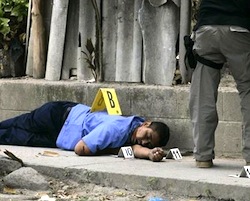A perfect storm of gang atomization, internal clashes, and vigilantism made El Salvador the Western Hemisphere’s bloodiest nation in 2015.
El Salvador ended the year with at least 6,640 murders, reported La Prensa Gráfica.
The grisly statistic represents close to a 70 percent increase over 2014 homicides and gives the country a homicide rate of 104.2 per 100,000 inhabitants, the report said.
El Salvador makes up 13.6 percent of Central America’s population, yet represents 35.3 percent of Central America’s homicides, the report added.
Speaking with Reuters, El Salvador’s Forensic Medicine Director Miguel Fortín Magaña described national homicide figures as “truly pandemic.”
InSight Crime Analysis
Some authorities have been quick to blame homicides on violent competition between street gangs. And while gangs — particularly El Salvador’s two largest groups, the Mara Salvatrucha (MS13) and the Barrio 18 — are responsible for a significant portion of the violence, the situation is more complicated.
To begin with, the gang violence is multi-layered, and in some ways the recent spike is related to a failed gang truce, initiated in 2012, between the MS13 and the two factions of the Barrio 18 — the Revolucionarios and the Sureños. Initally, the truce led to falling murder rates. However, as is evident now, that may have been more about coercion than acceptance amongst the gangs’ rank and file.
SEE ALSO: El Salvador’s Gang Truce: Positives and Negatives
After the truce unraveled, authorities moved imprisoned gang leaders who were mediating the talks back to maximum security prison, impeding their ability to command and creating an opening for mid-level gang members who were upset by the truce.
Following this shift, gangs appear to be fracturing into smaller, competing units and internal purges within the ranks have become a regular occurrence.
Gang cells, or cliques as they are known, are also making their own their decisions with regards to killings rivals and coordinating attacks against security forces, rather than waiting for the proverbial “green light” from the leadership in jail.
Security forces have responded to the violence with heavy-handed tactics. The more extreme incidents have included reports of summary executions of suspected gang members, as well as allegations of security forces’ participation in death squads.
In a recent report, El Salvador’s ombudsman said that security forces were linked to 90 percent of human rights abuse complaints and that a “ends justify the means” mentality exists within the police ranks.
Unfortunately the situation will likely continue for the foreseeable future. Citing police statistics, La Prensa Gráfica reported 72 murders within the first three days of 2016, including separate multiple homicides, and attacks on security forces and their families.

